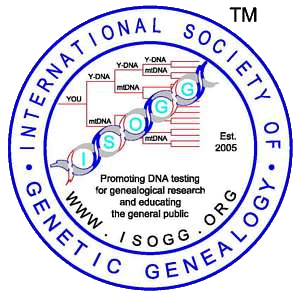About DMT and Louis Kessler
I've been an avid genealogist for over 40 years. My University training and degrees are in Statistics and Computer Science. Working with computers has been both a profession and an after-work pastime for me. And after initially dabbling with chess programming, the brunt of my after-work programming has been on genealogy software. I have been developing my Behold software for many years to be an important tool for my own genealogy research.
I've been a member of the Association of Software Professionals for many years until it ceased in 2021.

I'm a member of the Association of Professional Genealogists
![]()
And I'm a member of the Genealogical Speakers Guild.
How Double Match Triangulator Came To Be
I had been following the use of DNA testing for genealogy for several years, but never bit.In February 2016, I was a speaker on the 10th Unlock the Past Genealogy Cruise. One of the other speakers was Judy Russell, the Legal Genealogist. After one of her fantastic lectures, this one on DNA, I mentioned to her that I happened to have a 93 year old uncle. Well, Judy very forcefully told me that I had better go and get him tested as soon as I can.
When I got back, I asked my uncle if he would be willing to test for me. He agreed and I ordered a test kit from FamilyTreeDNA. It arrived and my uncle swabbed and we sent in the sample. I didn't know what to expect - what, maybe 300 matches? In June the results came back. He had over 7,000 matches. And of those, there was only one person, a third cousin, who I knew was a relative. None of the other 7,000 had surnames or locations that could be verified with the data I had.
Well that wasn't good enough for me. Here I had all this data with 7,000 potential relatives and no clues as to how to make use of it. I started using spreadsheets to organize my DNA matches. Then I learned about triangulation, which could help to identify common ancestors. I believed that was the key. It seemed like a big combinatoral problem which was right up my alley. I realized that triangulation could not be done from one person's segment matches. You needed a second person. So I contacted my third cousin and asked if he could send me his segment match file from FamilyTreeDNA. He did and I combined my file and his in a spreadsheet and identified what I called "Double Matches". But doing this manually in Excel was tedious. I decided I needed to develop a program to help me and Double Match Triangulator was born. I contacted many other people who had DNA matches with me and many of them sent me their segment match files when I asked. For more of this story, see my blog post: DNA or Bust.
I joined the International Society of Genetic Genealogy (ISOGG) and studied their wiki and followed and corresponded with many of the top genetic genealogists to learn everything I can about autosomal DNA analysis. Others were interested in DMT and encouraged me to continue to develop it. In August of 2016, I released version 1.0 of DMT. In September, the announcement of RootsTech 2017 came out and there was the Innovator Showdown competition, and I thought: why not? Following the requirements for entry, I created a page for DMT on Devpost and made the following YouTube video for it: Double Match Triangulator won 3rd place in the RootsTech 2017 Innovator Showdown. That was fun and being recognized for innovation was nice. But I'm still not there yet. I know DMT can do more. I'm sure it can be enhanced to be able to map your DNA segments to your ancestors based on the DNA-relatives you Double Match and Triangulate with. It looks to me to be a big mathematical puzzle that can be solved. Mapping segments is something several people like Tim Janzen and Jim Bartlett been able to do with their DNA manually. But it's a tedious process to do manually and took them years. I wanted DMT to automate this for me. Instead of taking years, it should take minutes.
